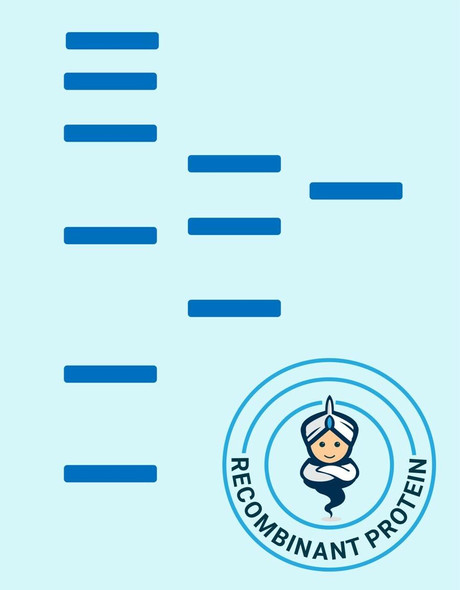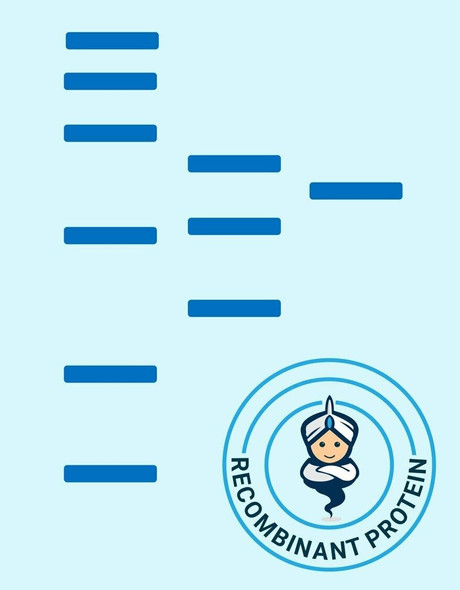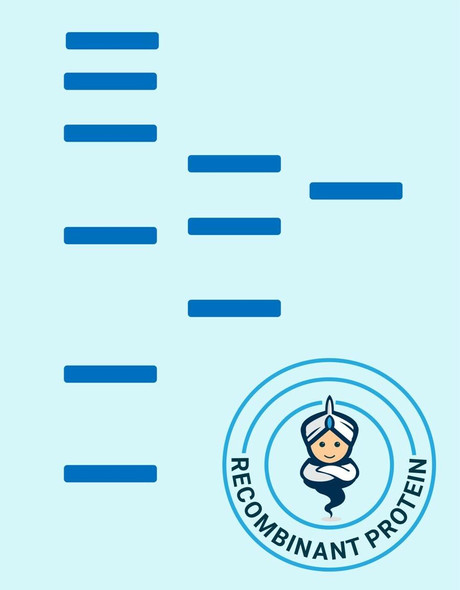Human PRL R Recombinant Protein (RPPB0880)
- SKU:
- RPPB0880
- Product type:
- Recombinant Protein
- Size:
- 20ug
- Species:
- Human
- Target:
- PRL R
- Synonyms:
- PRL-R
- hPRLrI
- Source:
- Escherichia Coli
- Uniprot:
- P16471
Description
| Product Name: | Human PRL R Recombinant Protein |
| Product Code: | RPPB0880 |
| Size: | 20µg |
| Species: | Human |
| Target: | PRL R |
| Synonyms: | PRL-R, hPRLrI. |
| Source: | Escherichia Coli |
| Physical Appearance: | Sterile filtered white lyophilized powder. |
| Formulation: | The Prolactin Receptor was lyophilized from a concentrated (0.4mg/ml) solution with 0.0045mM NaHCO3. |
| Solubility: | It is recommended to reconstitute the lyophilized PRLR in sterile 18M-cm H2O not less than 100µg/ml and not more than 1 mg/ml, which can then be further diluted to other aqueous solutions. |
| Stability: | Lyophilized PRL-R although stable at room temperature for 1-2 weeks, should be stored desiccated below -18°C or preferably even at -80°C to prevent dimer formation. Upon reconstitution PRL-R should be stored sterile at 4°C between 2-7 days and for future use below -18°C. For long term storage at 4°C it is recommended to add a carrier protein (0.1% HSA or BSA). Please prevent freeze-thaw cycles as they cause oligomerization of the protein. |
| Purity: | Greater than 97.0% as determined by:(a) Analysis by SEC-HPLC. (b) Analysis by SDS-PAGE.(c) Gel filtration at pH 8 under non denaturative conditions. |
| Amino Acid Sequence: | AGKPEIFKCRSPNKETFTCWWRPGTDGGLPTNYSLTYHREGETLMHECPDYITGGPNSCHFGKQYTSMWRTYIMMVNATNQMGSSFSDELYVDVTYIVQPDPPLELAVEVKQPEDRKPYLWIKWSPPTLIDLKTGWFTLLYEIRLKPEKAAEWEIHFAGQQTEFKILSLHPGQKYLVQVRCKPDHGYWSAWSPATFIQIPSDFTMNDTTVW |
| Biological Activity: | Activity is determined by the dose-dependant inhibition of Prolactin stimuled proliferation of Nb2 cells and by high affinity binding of ovine Prolactin and other lactogenic hormones in 1:1 molar ratio. |
Prolactin is a pituitary hormone that plays a role in the stimulation of milk production, salt and water regulation, growth, development and reproduction. The primary step in its action is the binding to a specific membrane receptor (prolactin receptor) which belongs to the superfamily of class 1 cytokine receptors. Prolactin is a hormone involved in a range of significant functions including ion transport and osmoregulation, stimulation of milk, protein synthesis as well as the regulation of numerous reproductive functions. Prolactin exerts its influence on different cell types through a signal transduction pathway which begins with the binding of the hormone to a transmembrane Prolactin receptor. PRLR varies in size (short and long forms) with tissue source and species, from ~40 kDa to 100 kDa. The PRL-R consists of at least 3 separate domains: an extracellular region with 5 cysteines which contains the prolactin binding site, a single transmembrane domain and a cytoplasmic region, the length of which appears to influence ligand binding and regulate cellular function.
Extra Cellular Domain Prolactin Receptor Human Recombinant produced in E.Coli is a non-glycosylated, Polypeptide chain containsing 210 amino acids and having a molecular mass of 23.97 kDa. The Prolactin Receptor is purified by proprietary chromatographic techniques according to Bignon et al. (1994) JBC 269; 3318-24 and tested according to Gertler et al. (1996) JBC 271; 24482-91.
| UniProt Protein Function: | PRLR: receptor for the anterior pituitary hormone prolactin and placental lactogen I and II. Interacts with Cyclophilin A, differentially regulating various signaling pathways from the PrlR. Prolactin signaling is attenuated by threonine and tyrosine phosphorylation. Two alternative splice isoforms have been identified. |
| UniProt Protein Details: | Protein type:Membrane protein, integral; Receptor, cytokine Chromosomal Location of Human Ortholog: 5p13.2 Cellular Component: cell surface; plasma membrane Molecular Function:peptide hormone binding; protein binding Biological Process: embryo implantation; transmembrane receptor protein tyrosine kinase activation (dimerization) Disease: Hyperprolactinemia; Multiple Fibroadenomas Of The Breast |
| NCBI Summary: | This gene encodes a receptor for the anterior pituitary hormone, prolactin, and belongs to the type I cytokine receptor family. Prolactin-dependent signaling occurs as the result of ligand-induced dimerization of the prolactin receptor. Several alternatively spliced transcript variants encoding different membrane-bound and soluble isoforms have been described for this gene, which may function to modulate the endocrine and autocrine effects of prolactin in normal tissue and cancer. [provided by RefSeq, Feb 2011] |
| UniProt Code: | P16471 |
| NCBI GenInfo Identifier: | 130321 |
| NCBI Gene ID: | 5618 |
| NCBI Accession: | P16471.1 |
| UniProt Secondary Accession: | P16471,Q16354, Q8TD75, Q8TD78, Q96P35, Q96P36, Q9BX87 Q9UHJ5, B2R882, D1MDP1, |
| UniProt Related Accession: | P16471 |
| Molecular Weight: | 70kDa |
| NCBI Full Name: | Prolactin receptor |
| NCBI Synonym Full Names: | prolactin receptor |
| NCBI Official Symbol: | PRLR |
| NCBI Official Synonym Symbols: | HPRL; MFAB; hPRLrI |
| NCBI Protein Information: | prolactin receptor |
| UniProt Protein Name: | Prolactin receptor |
| Protein Family: | Prolactin receptor |
| UniProt Gene Name: | PRLR |










